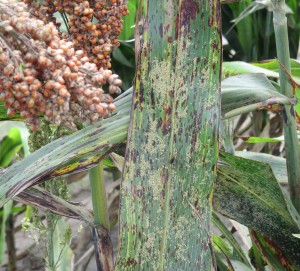–by Dr. J.P. Michaud, Hays, KS
South Texas had an abnormally cool and wet spring this year, and populations of sugarcane aphid were initially very low and mostly well controlled by natural enemies. However, with the onset of warmer, drier weather, economically significant aphid populations have now developed in the Rio Grande Valley and along the Gulf Coast. These are now producing winged forms with the potential to migrate northward. About 30% or the sorghum in south Texas has already been harvested, although later planted fields remain vulnerable and some are as much as one month away from harvest. However, harvested fields tend to re-sprout and thus may also serve as a source of migrant aphids, especially considering that no efforts will likely be made to control aphids in these situations. Thus, despite no reports from Kansas, and no economic infestations yet in Oklahoma (despite successful overwintering of the aphid on Johnson grass as far north as the TX-OK border), sorghum producers are advised to remain vigilant, especially with later-planted fields.
